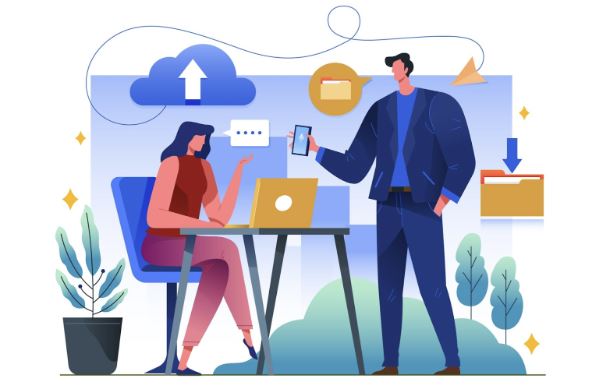Choosing between a help desk and a service desk can be challenging. The terms are often interchangeably used as most believe they deliver the same outcome: fixing tech-related issues. That notion would have been true a decade (or more) ago, but not anymore. The intricacies between a service desk and a help desk are subtle but different. In this article, we share the differences and the value they bring to IT support and business.
What is a Help Desk?
A help desk solves immediate problems, generally IT issues, such as slow-running software, glitches, connectivity issues, blue screens of death, and more. In ITSM (IT Service Management), this is referred to as incident management. Help desks enable an organization to provide support at scale, driving employee and customer satisfaction.
Additionally, a help desk for employees (internal help desk) is a cloud-based solution that allows employees to submit requests and manage devices, catalog, and monitor them all in one place. Essentially, it is an internal point of contact for employees to raise service requests for any technical issues within the organization.
Some key features of a help desk include:
- Managing the lifecycle of incidents or service requests raised by end users
- Managing the lifecycle of a problem or change from end to end
- Allowing employees to resolve issues themselves and reduce the IT admin’s workload
- Managing the quality and timeline of services provided to employees or customers
What is a Service Desk?
The ITIL (formerly known as Information Technology Infrastructure Library) defines a service desk as follows, “The single point of contact between the service providers and users. A typical service desk manages incidents and service requests and also handles communication with the users”.
Service desks include multiple ITSM activities, including:
- Incident management: Restoring normal services when something goes awry
- Service request management: Authorizing user access to new technology
- Knowledge management: Creating and publishing helpful documentation for users
- Self-service kiosk: Enabling users to resolve their tech-related issues
- Reporting: Notifying concerned parties about changes, issues, or events
IT service desks may include more or less of these capabilities. Still, overall they offer a robust, service-oriented, and customer-centric way of delivering help from IT to end users.
The Difference: Service Desk vs. Help Desk
Help desks are user-centric. Service desks are business-centric.
The core function of a help desk is to handle incidents (or immediate/infrequent fixes) and service requests. It aims to quickly fix user issues by handling requests through its lifecycle and returning its service to its normal state at the earliest. So the focus is always on the user.
On the other hand, the service desk focuses on the business needs instead of the user’s request. Unlike responding to incidents and fulfilling individual requests, a service desk reviews the overall IT and business processes within the organization with the goal of continuous improvement. Thus, a help desk can be viewed as a subset of a service desk.
Help Desk
The help desk is user-centric
The service desk is business-centric
The help desk is tactical and reactive
The service desk is strategic and proactive
The help desk can run on minimal staff
Service Desk
The service desk usually requires more staff
The help desk includes a helpdesk ticketing system and self-service capabilities
The service desk can include several modules: incident, problem, change, knowledge, and asset management
The help desk is a point/standalone solution that focuses on solving end-user problems
The service desk can integrate with IT and non-IT management solutions and therefore operates on a holistic approach that aligns with business changes
Help desks are a subset of service desks
Help desks are considered a subset of service desks, limited to a single ITSM activity, such as incident management or break-fix process. Whereas service desks offer a broader range and more complex services, as mentioned above.
Most service desk systems in the market can be used as help desks, but it does not apply the other way around. Many organizations incorporate help desks as a part of their service desks.
Help desks are standalone solutions. Service desks are integrated.
A help desk is a standalone solution that focuses on break-fix (incident management) situations. They usually offer basic incident and problem management capabilities with SLAs and self-service portals.
A service desk is elaborate and offers a range of IT management capabilities. It is integrated with other IT service management processes and can provide advanced services like mobile application management, CMDB management, release management, and more.
Help desks are reactive. Service desks are proactive.
As mentioned earlier, help desks are predominantly configured for break-fix processes that aim to meet the immediate needs of end users. For instance, an employee can raise a ticket to fix an issue.
The help desk focuses on repair. With the service desk, the focus is on prevention. It ensures that IT operations are running as expected and will continue to run in the future. Service desks can perform reactive tasks, but they prioritize ensuring uninterrupted IT operations.
Benefits of Help Desks and Service Desks
1. Automation
Service and help desks offer automation tools that replace manual tasks, helping users avoid repetitive and mundane tasks. Users also can create and set rules that will automate specific tasks.
For instance, if a high-priority issue is raised, the most capable individual to resolve the situation is automatically notified and assigned the ticket. Another use of automation is to create automated follow-up notifications if an employee forgets to close the issue ticket or adds a new comment.
2. Self-service reduces workload and boosts satisfaction
In the era of instant gratification, people expect an immediate reply to their requests. Building a knowledge base software with readily available information provides customers and employees with answers to questions, resulting in a better customer experience and employee satisfaction.
Deploying self-service resources such as FAQs, product and service manuals, troubleshooting guides, employee handbooks, and how-to video guides will help people solve issues by themselves. Additionally, using a step-by-step guide creator allows businesses to develop customized, easy-to-follow guides for specific tasks, further enhancing the self-service experience and empowering users to find solutions on their own. Not only does this reduce the support staff's workload, but it also greatly improves satisfaction scores.
3. Improves services and products
Service desk software collects a large amount of data regarding customer interactions. The data can deliver actionable insights to business partners to make informed decisions. Service desk managers can change employee training, tweak current workflows, plan budgets better, and deliver better customer service. Businesses can use the service desk data to understand customer pain points and challenges to improve products and services and further optimize experience at different stages of the sales pipeline.
Wrapping Up
So now that you know the difference between the two, which one should you choose? That’s a question for different companies with different answers. Some companies may be comfortable with using a help desk for years, while others may decide to onboard a service desk from the start. The choice depends on satisfying the current needs or futureproofing customer service strategies.


.jpg)




